我用Cocos2d-x模拟《Love Live!学院偶像祭》的Live场景(二)
上一章分析了Live场景中各个元素的作用,这一章开始来分析最关键的部分——打击物件的实现。
上一章放出的视频很模糊,先来看一个清晰版的复习一下:http://www.bilibili.com/video/av1087466/
然后说一下我使用的环境:Win8.1 + VS2013 + Cocos2d-x3.2
接下来为后文作点准备工作:
1、 创建一个空的cocos2d-x项目;
2、 把HelloWorldScene类和它的两个源码文件改名。我使用的名称是LiveScene;
3、 删掉LiveScene类中多余的代码,比如添加一个“Hello World”的Label这种的(说实话cocos2d-x创建空项目每次都要带个这个类挺蛋疼,因为99.99999%的情况我们的项目中根本不需要它,直接创建一个干净的空项目多好);
4、 删掉Resource文件夹中的所有文件;
5、 在AppDelegate类中修改设计分辨率为960×640,像下面这样:
1 2 3 4 5 6 7 8 9 10 | bool AppDelegate::applicationDidFinishLaunching() { // ... if(!glview) { glview = GLView::create("My Game"); glview->setFrameSize(960, 640); director->setOpenGLView(glview); glview->setDesignResolutionSize(960, 640, ResolutionPolicy::SHOW_ALL); } // ...} |
准备工作做完后,可以先编译运行一下。如果跑起来一片黑,那么就OK可以继续了。
准备工作完成,开始分析打击物件。从视频看,打击物件有个3D透视效果:近大远小。Cocos2d-x 3.x的版本已经支持3D模型,可以制作3D游戏了。但是对于这个比较简单的效果,直接上3D有点大炮打蚊子的感觉。可以运用3D透视公式,根据物件的Z轴距离计算出在屏幕上的X和Y坐标以及缩放。
等等,仔细看看那个视频,感觉物件飞过来的过程,和真正的3D比还是有点违和啊……于是,LL(《Love Live!学院偶像祭》,以后都简称LL)中真的是用的3D吗?
此时需要检测一下了。先说一下我的思路:对于下图所示的三个三连打物件,他们的时间间隔是一样的。如果使用了3D透视,那么后两个的屏幕坐标间距一定小于前两个,近大远小嘛。
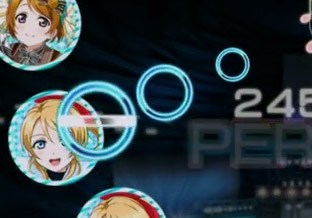
还是不大能理解?来看看这么一张图(图片源自网络):

不要吐槽远景那些莫名其妙的东西……我们来看铁轨,是不是从画面上看,越远处的枕木越密集?但是实际上枕木和枕木之间的间距是一样的。这个现象用计算机图形学的术语讲,其实就是世界坐标系到摄像机坐标系的变换形成的。因为屏幕上没有Z轴,只有X和Y,物体的Z轴变化只能通过移动位置和缩放来表现。
扯远了,用这一点来验证LL是否使用了3D透视,就是因为物件飞过来的时候,它们的Z轴速度肯定是一定的(从一个音乐游戏来讲,如果是变速运动这游戏基本上没法玩了),而三个物件的时间间隔相同,那么经过坐标变换必然形成后两个的屏幕坐标间距一定小于前两个。
那么打开神奇PS,将三个圆的中心标出来,连上线。不会PS没关系,我把图做好了。背景有点花?盖个黑色图层:
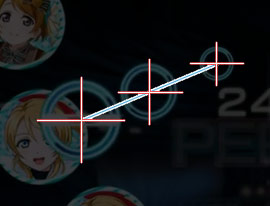
能明显看出,三个圆之间的屏幕距离是相等的。于是乎,这个效果根本没有使用3D透视变换。也就是说,物件在飞向屏幕的过程中,在屏幕上移动的速度也是不变的。
于是事情变得简单了,不需要去计算透视变换了。对于单个的一列,物件飞过来就是X轴不变,Y轴匀速运动。再从飞出来的点拉两条射线出来:
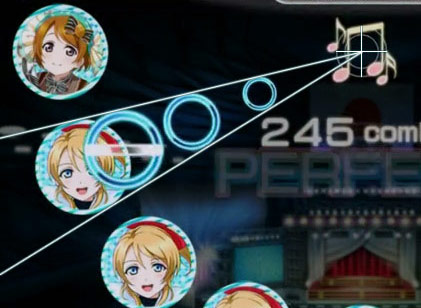
艾玛,缩放也是匀变化的,取值就是一个f(x) = kx + b的一元线性方程嘛。接下来我们来求这个方程的参数k和b。
为了方便测量,以最中间的按钮为准。从视频看这个游戏的长宽比是3:2的,所以文章开始说的的设计分辨率要取960×640。测量值写在图片上了(怎么测量属于PS的应用,与这一系列文章无关,这里就不做介绍了):
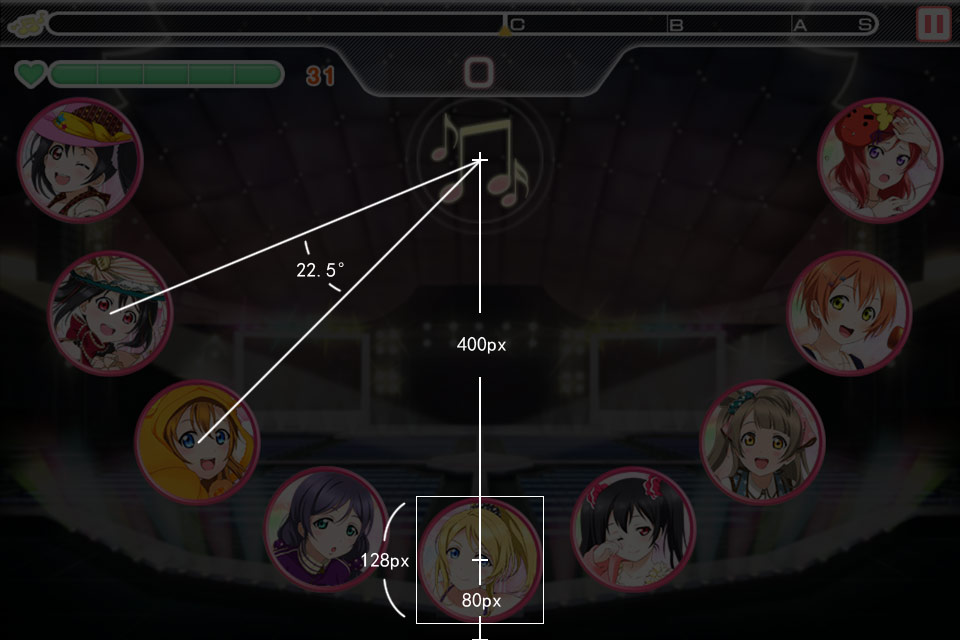
所以就可以知道:物件在0px高度的时候,缩放是0,在-400px高度的时候,缩放是1(这里定义列的锚点是物件出现的点,以方便后续做旋转操作,所以物件的y是从0开始逐渐变小的)。所以可以求得缩放方程式是
scale = -0.0025 * y
可以看出对于圆圈物件,就是一个Sprite对象。对于长条物件,是一个Sprite做头,一个Sprite做中间,一个Sprite做尾。
对于圆圈物件来说,我只要处理缩放和坐标就行。而对于Sprite的中间,则是一个随时在变化的梯形。
Cocos2d-x提供了setSkew方法对Sprite进行扭曲,但是这个扭曲只是一个平行四边形变换,并不是梯形。我们知道OpenGL渲染图形是先渲染顶点,再渲染像素的。所以修改Sprite的四个顶点可以达到想要的效果。说到顶点,自然就想到了顶点着色器,想到了GLSL。不过,这个效果怎么说也不复杂,杀鸡焉用牛刀呢。其实,在Sprite类中有一个成员(CCSprite.h 563行):
1 2 | // vertex coords, texture coords and color infoV3F_C4B_T2F_Quad _quad; |
注释说,这个成员就是Sprite的四个顶点。V3F_C4B_T2F_Quad又是个啥玩意?看看结构定义(ccTypes.h 291行):
1 2 3 4 5 6 7 8 9 10 11 12 | //! 4 Vertex3FTex2FColor4Bstruct V3F_C4B_T2F_Quad{ //! top left V3F_C4B_T2F tl; //! bottom left V3F_C4B_T2F bl; //! top right V3F_C4B_T2F tr; //! bottom right V3F_C4B_T2F br;}; |
里面果然是四个成员,分别表示左上,左下,右上,右下四个顶点。而顶点的结构V3F_C4B_T2F是这样的(ccTypes.h 245行):
1 2 3 4 5 6 7 8 9 10 11 12 | //! a Vec2 with a vertex point, a tex coord point and a color 4Bstruct V3F_C4B_T2F{ //! vertices (3F) Vec3 vertices; // 12 bytes //! colors (4B) Color4B colors; // 4 bytes // tex coords (2F) Tex2F texCoords; // 8 bytes}; |
这三个成员分别表示:顶点坐标,顶点颜色和UV纹理贴图坐标。我们只需要处理位置即可。然而,_quad成员是一个protected对象,Sprite类也没有对外提供访问接口。因为对象时protected的,我们可以派生一个Sprite类的子类,提供访问_quad的接口。
在项目中添加VertexSprite.h和VertexSprite.cpp,将接口暴露出来(憋了这么久,终于可以敲代码了)。首先是头文件:
1 2 3 4 5 6 7 8 9 10 11 12 13 14 15 16 17 18 19 20 21 22 23 24 25 26 | #ifndef __VERTEX_SPRITE_H__#define __VERTEX_SPRITE_H__#include "cocos2d.h"USING_NS_CC;class VertexSprite : public Sprite{public: static VertexSprite* create(const std::string& filename); bool initWithFile(const std::string& filename); /* * 设置四个顶点的坐标 * @param pTL 左上角顶点坐标 * @param pBL 左下角顶点坐标 * @param pTR 右上角顶点坐标 * @param pBR 右下角顶点坐标 */ void SetVertex(const Vec2& pTL, const Vec2& pBL, const Vec2& pTR, const Vec2& pBR);private: VertexSprite(){}};#endif // __VERTEX_SPRITE_H__ |
然后是实现文件:
1 2 3 4 5 6 7 8 9 10 11 12 13 14 15 16 17 18 19 20 21 22 23 24 25 26 27 28 29 30 31 32 33 34 35 36 37 38 39 40 41 42 43 44 45 46 | #include "VertexSprite.h"VertexSprite* VertexSprite::create(const std::string& filename){ auto ret = new VertexSprite(); if (ret->initWithFile(filename)) { ret->autorelease(); } else { CC_SAFE_DELETE(ret); } return ret;}bool VertexSprite::initWithFile(const std::string& filename){ return Sprite::initWithFile(filename);}void VertexSprite::SetVertex(const Vec2& pTL, const Vec2& pBL, const Vec2& pTR, const Vec2& pBR){ // Top Left // this->_quad.tl.vertices.x = pTL.x; this->_quad.tl.vertices.y = pTL.y; // Bottom Left // this->_quad.bl.vertices.x = pBL.x; this->_quad.bl.vertices.y = pBL.y; // Top Right // this->_quad.tr.vertices.x = pTR.x; this->_quad.tr.vertices.y = pTR.y; // Bottom Right // this->_quad.br.vertices.x = pBR.x; this->_quad.br.vertices.y = pBR.y; this->setContentSize(Size(0, pTL.y - pBL.y));} |
可以看到SetVertex方法的最后做了一下setContentSize的操作。为什么呢?因为Sprite绘制的时候,会判断自己是否在显示区域内,如果不在,则不绘制(CCSprite.cpp 586行):
1 2 3 4 5 6 7 8 9 10 11 12 13 14 15 16 17 18 | // drawvoid Sprite::draw(Renderer *renderer, const Mat4 &transform, uint32_t flags){ // Don't do calculate the culling if the transform was not updated _insideBounds = (flags & FLAGS_TRANSFORM_DIRTY) ? renderer->checkVisibility(transform, _contentSize) : _insideBounds; if(_insideBounds) { _quadCommand.init(_globalZOrder, _texture->getName(), getGLProgramState(), _blendFunc, &_quad, 1, transform); renderer->addCommand(&_quadCommand);#if CC_SPRITE_DEBUG_DRAW _customDebugDrawCommand.init(_globalZOrder); _customDebugDrawCommand.func = CC_CALLBACK_0(Sprite::drawDebugData, this); renderer->addCommand(&_customDebugDrawCommand);#endif //CC_SPRITE_DEBUG_DRAW }} |
所以设置顶点坐标后,还需要手动设置它的_contentSize。如果不设置,这个值默认就是我们使用的贴图的大小,即1px × 1px。所以在没设置的情况下,这个Sprite稍微移出显示区域一点,整个Sprite就不会显示了。所以我们需要在设定顶点后,手动去修改它的_contentSize。为了节约运算资源,以及考虑到可能出现的情况(只会是梯形,不会出现凹四边形等情况),这里直接设置_contentSize的高度就行了,可以减少一定的运算量。
目前只写了一个从文件创建对象的create方法。当然,今后为了各种需求可以也可以加入其他的比如createWithSpriteFrame等等。
有了一个可设定顶点坐标的类,接下来就可以编写物件类:BeatObject类了。根据框架设计,画面表现部分和数据部分是分开的,所以BeatObject类不能存放这个BeatObject出现的时间等数据,外部仅能改变BeatObject的位置。
当外部调用BeatObject的setPositionY方法(物件只会纵向移动,不应当修改x坐标)时,应当会做如下操作:
1、 计算出头的缩放值;
2、 如果这个BeatObject的类型是Strip,则根据BeatObject的长度计算出尾部的坐标和缩放值;
3、 如果这个BeatObject的类型是Strip,再计算出中间部分的四个顶点坐标。
四个顶点的坐标和尾部的缩放怎么计算呢?请看图:
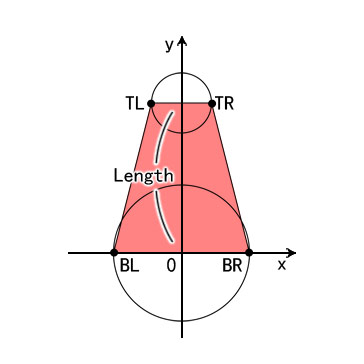
如图所示是一个Strip物件的示意图。下面的圆是头部,上面的圆是尾部,中间红色的梯形就是我们要进设置顶点的中间部。TL, BL, TR, BR则是四个顶点,直接对应_quad成员中的四个成员。
Length值是由外部设置进去的,表示头部圆心到尾部圆心的长度,也就是梯形的高。头部圆的缩放的公式上文推导出了,尾部圆的缩放公式则是
-0.0025 * (y + length)
y值就是这个坐标系中的原点相对于Colume节点的高度。
我使用的图中,头部尾部的图像虽然是128px×128px,但是圆圈本身有个外发光,导致圆圈实际没有128px那么大。这里我取124px作为中间部一倍缩放宽度。实际制作的时候,这个宽度值应当根据使用的图像作出适当调整。于是,四个顶点的坐标取值如下:
TL: x = -尾部缩放 × 124 / 2, y = length
BL: x = -头部缩放 × 124 / 2, y = 0
TR: x = 尾部缩放 × 124 / 2, y = length
BR: x = 头部缩放 × 124 / 2, y = 0
我使用一个enum来区分BeatObject的类型。这个enum存放在Common.h中,因为在使用物件数据的时候还会用上。圈叫Block因为在传统下落式音乐游戏中那玩意叫“块”。Common.h的内容如下:
1 2 3 4 5 6 7 8 9 10 11 12 13 14 15 16 | #ifndef __COMMON_H__#define __COMMON_H__enum BeatObjectType : int{ Invalid = 0x0000, Block = 0x0001, Strip = 0x0002, SameTime = 0x0004, Star = 0x0008};#define WASSERT(__COND__) if(!(__COND__)){ DebugBreak(); }#endif // __COMMON_H__ |
WASSERT宏用于在断言符合时产生一个断点,而不是生成报错对话框,这样可以方便调试。
如下是BeatObject类的代码,首先是头文件:
1 2 3 4 5 6 7 8 9 10 11 12 13 14 15 16 17 18 19 20 21 22 23 24 25 26 27 28 29 30 31 32 33 34 35 36 37 38 39 40 41 42 43 44 45 46 | #ifndef __BEAT_OBJECT_H__#define __BEAT_OBJECT_H__#include "cocos2d.h"#include "Common.h"#include "VertexSprite.h"USING_NS_CC;class BeatObject : public Node{public: /* * 创建一个BeatObject实例 * @param pType BeatObject类型,参考BeatObjectType * @param pLength BeatObject的长度,仅当该实例为Strip类型时有效 */ static BeatObject* create(int pType, float pLength = 0); ~BeatObject(){}public: // Getter bool IsBlock(); bool IsStrip();public: // Setter void setPositionY(float y) override; void setRotation(float rotation) override;private: BeatObject(); bool init(int pType, float pLength = 0); // 不允许外部修改BeatObj的坐标 void setPosition(const Vec2& position){ Node::setPosition(position); } void setPositionX(float x){ Node::setPositionX(x); }private: int m_nType; Sprite* m_pHead; Sprite* m_pTail; VertexSprite* m_pBody; float m_fLength; float m_fCurLength;};#endif // __BEAT_OBJECT_H__ |
实现:
1 2 3 4 5 6 7 8 9 10 11 12 13 14 15 16 17 18 19 20 21 22 23 24 25 26 27 28 29 30 31 32 33 34 35 36 37 38 39 40 41 42 43 44 45 46 47 48 49 50 51 52 53 54 55 56 57 58 59 60 61 62 63 64 65 66 67 68 69 70 71 72 73 74 75 76 77 78 79 80 81 82 83 84 85 86 87 88 89 90 91 92 93 94 95 96 97 98 99 100 101 102 103 104 105 106 107 108 109 110 111 112 113 114 115 116 117 118 119 120 121 122 123 124 125 126 127 128 129 130 131 132 133 134 135 136 137 138 139 140 141 142 143 144 145 146 147 148 149 150 151 152 153 154 155 156 157 158 159 160 161 162 163 | #include "BeatObject.h"namespace{ inline float GetMoveScale(float pY) { if (pY >= 0) { return 0; } return -0.0025f * pY; } inline bool TypeContains(int pType, const BeatObjectType& pTarType) { return (pType & pTarType) == pTarType; }}//////////////////////////////////////////////////////////////////////////// BeatObjectBeatObject::BeatObject() : m_nType(BeatObjectType::Invalid) , m_pHead(nullptr) , m_pTail(nullptr) , m_pBody(nullptr) , m_fLength(0) , m_fCurLength(0){}BeatObject* BeatObject::create(int pType, float pLength /* = 0 */){ auto ret = new BeatObject(); if (ret->init(pType, pLength)) { ret->autorelease(); } else { CC_SAFE_DELETE(ret); } return ret;}bool BeatObject::init(int pType, float pLength /* = 0 */){ if (!Node::init()) { return false; } this->m_nType = pType; WASSERT(TypeContains(this->m_nType, BeatObjectType::Invalid)); // 不允许对Block类型设置Length // 以及不允许设置Strip类型的Length小于等于0 // if (pLength > 0) { WASSERT(this->IsStrip()); } else if (pLength < 0) { WASSERT(false); } this->m_fLength = pLength; if (this->IsStrip()) { this->m_pBody = VertexSprite::create("Strip_Body.png"); this->m_pTail = Sprite::create("Strip_Tail.png"); this->m_pBody->setAnchorPoint(Vec2(0.5f, 0)); this->addChild(this->m_pBody); this->addChild(this->m_pTail); this->m_pTail->setVisible(false); } this->m_pHead = Sprite::create("Block.png"); this->addChild(this->m_pHead); if (TypeContains(this->m_nType, BeatObjectType::Star)) { auto s = Sprite::create("Star.png"); s->setPosition(this->m_pHead->getContentSize() / 2); this->m_pHead->addChild(s); } if (TypeContains(this->m_nType, BeatObjectType::SameTime)) { auto st = Sprite::create("SameTime.png"); st->setPosition(this->m_pHead->getContentSize() / 2); this->m_pHead->addChild(st); } return true;}bool BeatObject::IsBlock(){ return TypeContains(this->m_nType, BeatObjectType::Block);}bool BeatObject::IsStrip(){ return TypeContains(this->m_nType, BeatObjectType::Strip);}void BeatObject::setPositionY(float y){ Node::setPositionY(y); // 设置圆圈的缩放。若缩放太小直接不显示 // auto headScale = GetMoveScale(y); this->m_pHead->setScale(headScale); this->m_pHead->setVisible(headScale > 0.05f); // 如果该物件是一个Strip,则需要处理其身体和尾部 // if (this->IsStrip()) { // 模拟无限远处飞来的效果,保证尾部的y坐标小于0 // if (y + this->m_fLength > 0) { this->m_fCurLength = -y; } else if (this->m_fCurLength != this->m_fLength) { this->m_fCurLength = this->m_fLength; this->m_pTail->setPositionY(this->m_fLength); } auto tailScale = GetMoveScale(this->getPositionY() + this->m_fCurLength); this->m_pTail->setScale(tailScale); this->m_pTail->setVisible(tailScale > 0.05f); auto harfHeadWidth = headScale * 124 / 2.0f; auto harfTailWidth = tailScale * 124 / 2.0f; this->m_pBody->SetVertex( Vec2(-harfTailWidth, this->m_fCurLength), Vec2(-harfHeadWidth, 0), Vec2(harfTailWidth, this->m_fCurLength), Vec2(harfHeadWidth, 0)); }}void BeatObject::setRotation(float rotation){ this->m_pHead->setRotation(rotation);} |
BeatObject类开放并重写setPositionY方法,屏蔽setPosition和setPositionX,不允许外部直接修改BeatObject的坐标。这里还重写了setRotation方法,但是并没有调用基类的setRotation,原因后面来讲。
BeatObject类目前就是这样了,今后需要其他功能再逐渐添加。接下来我们创建BeatObject的父节点类:BeatObjectColume。
每个物件在运动的时候,都不会离开它们所在的列。换句话说,就是一个在第一列的物件,在任何时候都不会跑到第二列去。BeatObjectColume类就表示一个列。这个类目前比较简单,我就直接放代码了,头文件:
1 2 3 4 5 6 7 8 9 10 11 12 13 14 15 16 17 18 19 20 21 22 23 24 25 26 27 28 29 30 31 32 | #ifndef __BEAT_OBJECT_COLUME_H__#define __BEAT_OBJECT_COLUME_H__#include "cocos2d.h"#include "BeatObject.h"USING_NS_CC;class BeatObjectColume : public Node{public: CREATE_FUNC(BeatObjectColume); ~BeatObjectColume();public: void AddBeatObject(BeatObject* pObj); void ClearObjects(); void SetObjectPositionY(int pIndex, float pY);private: void addChild(Node *child){ Node::addChild(child); }private: BeatObjectColume(); bool init();private: std::vector<BeatObject*> m_BeatObjList;};#endif // __BEAT_OBJECT_COLUME_H__ |
实现:
1 2 3 4 5 6 7 8 9 10 11 12 13 14 15 16 17 18 19 20 21 22 23 24 25 26 27 28 29 30 31 32 33 34 35 36 37 38 39 40 41 42 43 44 45 46 47 48 49 | #include "BeatObjectColume.h"BeatObjectColume::BeatObjectColume(){}bool BeatObjectColume::init(){ if (!Node::init()) { return false; } return true;}void BeatObjectColume::AddBeatObject(BeatObject* pObj){ pObj->setRotation(-this->getRotation()); this->addChild(pObj); this->m_BeatObjList.push_back(pObj);}void BeatObjectColume::ClearObjects(){ for (auto it : this->m_BeatObjList) { it->removeFromParent(); } this->m_BeatObjList.clear();}void BeatObjectColume::SetObjectPositionY(int pIndex, float pY){ WASSERT(pIndex >= 0 && pIndex < this->m_BeatObjList.size()); this->m_BeatObjList.at(pIndex)->setPositionY(pY);}BeatObjectColume::~BeatObjectColume(){ this->m_BeatObjList.clear();} |
注意在AddBeatObject这个方法中,对添加进去的BeatObject进行了一个旋转处理。为什么呢?因为列是呈扇形分开的,除开最中间的列,其他列都进行过旋转处理。而我们看视频截图:
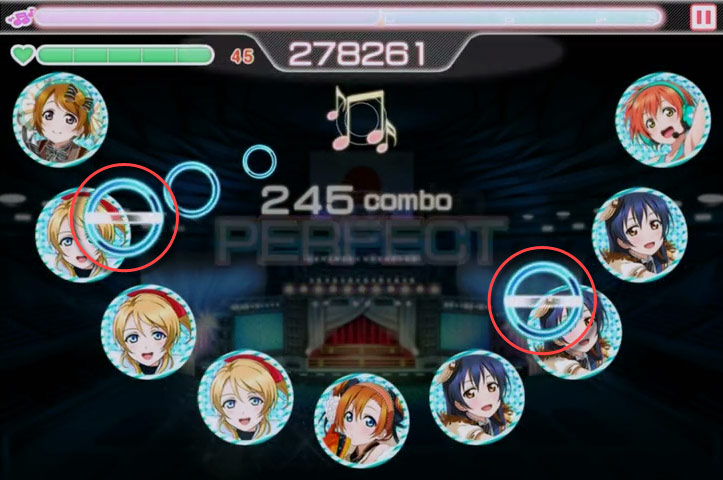
可以看出在列旋转后,对于Block物件,它相对于屏幕其实是没有旋转的,对于Strip物件(图中没有),它的头对于屏幕也是没有旋转的。所以在添加BeatObject的时候,要对它进行一个和Colume方向相反,大小相同的旋转。而因为Strip物件只有头部进行了旋转,所以上文说的不必调用基类的setRotation。
然后我们在LiveScene类中加入一些东西,看看我们实现的成果(因为是临时使用的代码,变量使用不太规范)。头文件:
1 2 3 4 5 6 7 8 9 10 11 12 13 14 15 16 17 18 19 20 21 22 23 24 25 26 27 28 29 | #ifndef __LIVE_SCENE_H__#define __LIVE_SCENE_H__#include "cocos2d.h"#include "BeatObject.h"#include "BeatObjectColume.h"USING_NS_CC;class LiveScene : public cocos2d::Layer{public: // there's no 'id' in cpp, so we recommend returning the class instance pointer static cocos2d::Scene* createScene(); // Here's a difference. Method 'init' in cocos2d-x returns bool, instead of returning 'id' in cocos2d-iphone virtual bool init(); // implement the "static create()" method manually CREATE_FUNC(LiveScene);private: void update(float dt);private: BeatObjectColume* m_pColume;};#endif // __LIVE_SCENE_H__ |
实现:
1 2 3 4 5 6 7 8 9 10 11 12 13 14 15 16 17 18 19 20 21 22 23 24 25 26 27 28 29 30 31 32 33 34 35 36 37 38 39 40 41 42 43 44 45 46 47 48 49 50 51 52 53 54 55 56 57 58 59 60 61 62 | #include "LiveScene.h"Scene* LiveScene::createScene(){ // 'scene' is an autorelease object auto scene = Scene::create(); // 'layer' is an autorelease object auto layer = MainScene::create(); // add layer as a child to scene scene->addChild(layer); // return the scene return scene;}// on "init" you need to initialize your instancebool LiveScene::init(){ if (!Layer::init()) { return false; } // 加入背景图 // auto bg = Sprite::create("bg.jpg"); bg->setPosition(480, 320); this->addChild(bg); // 加上黑色半透明蒙层 // auto colorLayer = LayerColor::create(Color4B(0, 0, 0, 192)); this->addChild(colorLayer); // 加上一个列 // this->m_pColume = BeatObjectColume::create(); this->m_pColume->setPosition(480, 480); this->addChild(this->m_pColume); // 添加一个BeatObject // 如果要添加Block类的Object,则 // auto obj = BeatObject::create(BeatObjectType::Block); auto obj = BeatObject::create(BeatObjectType::Strip | BeatObjectType::SameTime, 256); this->m_pColume->AddBeatObject(obj); this->scheduleUpdate(); return true;}float moveY = 0;void LiveScene::update(float dt){ this->m_pColume->SetObjectPositionY(0, moveY); moveY -= 4; if (moveY < -960) { moveY = 0; }} |
编译运行,如果没有问题的话,看到这样的效果:
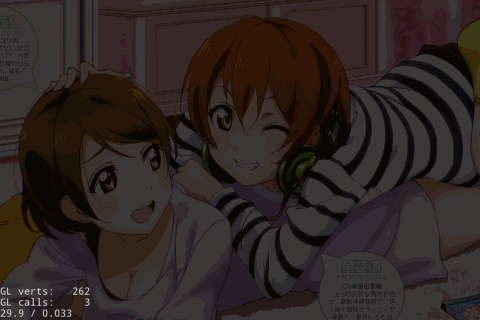
这一章就结束了。下一章我们来编写一个BeatObjectManager,将所有的Object管理起来,并通过数据显示我们想要的谱面。
本章所用到的资源:http://pan.baidu.com/s/1dDk0TXZ





【推荐】国内首个AI IDE,深度理解中文开发场景,立即下载体验Trae
【推荐】编程新体验,更懂你的AI,立即体验豆包MarsCode编程助手
【推荐】抖音旗下AI助手豆包,你的智能百科全书,全免费不限次数
【推荐】轻量又高性能的 SSH 工具 IShell:AI 加持,快人一步
· go语言实现终端里的倒计时
· 如何编写易于单元测试的代码
· 10年+ .NET Coder 心语,封装的思维:从隐藏、稳定开始理解其本质意义
· .NET Core 中如何实现缓存的预热?
· 从 HTTP 原因短语缺失研究 HTTP/2 和 HTTP/3 的设计差异
· 周边上新:园子的第一款马克杯温暖上架
· 分享 3 个 .NET 开源的文件压缩处理库,助力快速实现文件压缩解压功能!
· Ollama——大语言模型本地部署的极速利器
· DeepSeek如何颠覆传统软件测试?测试工程师会被淘汰吗?
· 使用C#创建一个MCP客户端